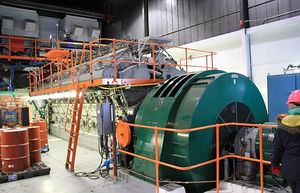Diesel generator

Diesel generators are very useful machines that produce electricity by burning diesel fuel. These machines use a combination of an electric generator and a diesel engine to generate electricity. Diesel generators convert some of the chemical energy, contained by the diesel fuel, to mechanical energy through combustion. This mechanical energy then rotates a crank to produce electricity. Electric charges are induced in the wire by moving it through a magnetic field. In an electric generator application, two polarized magnets usually produce the magnetic field. A wire is then wound around the crankshaft of the diesel generator many times, which is placed between the magnets and in the magnetic field. When the diesel engine rotates the crankshaft, the wires are then moved throughout the magnetic field, which can induce electric charges in the circuit. A general rule of thumb is that a diesel generator will use 0.4 L of diesel per kWh produced. The diesel engine used is essentially an internal combustion engine. Unlike a gasoline engine, the diesel engine uses the heat of compression to ignite and burn the fuel that has been injected into the injection chamber. In general, diesel engines have the highest thermal efficiency out any internal combustion engine, which allow to achieve an approximate percentage of the Carnot efficiency. Diesel engines can operate off of many derivatives of crude oil. The fuels a diesel engine may use for combustion include natural gas, alcohols, gasoline, wood gas and diesel.[2]
Versatility
Diesel generators are used in many versatile applications around the globe. Typically they are set up in rural places where they are connected to a power grid and can be used as the main power source or for a backup system. Diesel generators can also be used to offset the peaking power needs on the grid because they can quickly be turned on and off without inducing any lag time. Generators used in residential settings can range anywhere from 8 to 30 kW while generators used for commercial settings can range anywhere from 8 KW to 2,000 KW. Large ships also utilize diesel generators for auxiliary power purposes, which can range from lights, fans and switches to supplementing power to the propulsion system.
Emissions
Burning diesel or other fuels creates exhaust gasses. Diesel generators produce carbon dioxide (CO2), nitrogen oxide (NOx), and particulate matter. These generators release this into the atmosphere and substantially reduce air quality in the nearby regions. Every litre of fuel has 0.73 kg of pure carbon, 2.6 kg of carbon dioxide released per liter of diesel fuel.
References
- ↑ “A Tour of Yukon Energy’s Whitehorse Power Plants.” [Online]. Available: http://explorenorth.com/wordpress/a-tour-of-yukon-energys-whitehorse-power-plants/. [Accessed: 28-Mar-2014].
- ↑ Annaratone D., Steam Generators: Descirption and Design. Milano: Springer, 2007.

